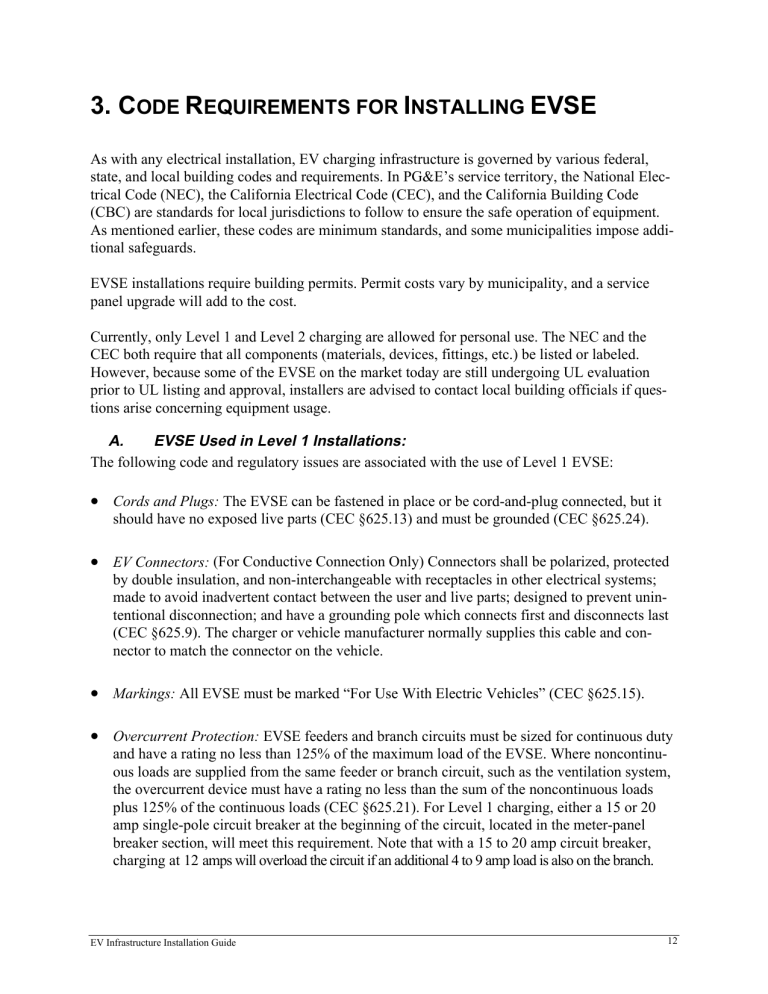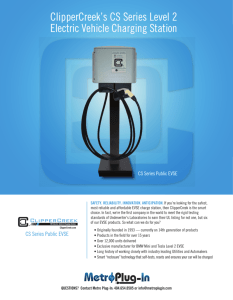Uploaded by
maher.elkani
EVSE Installation Code Requirements: Level 1 & 2 Charging Guide
advertisement

3. CODE REQUIREMENTS FOR INSTALLING EVSE As with any electrical installation, EV charging infrastructure is governed by various federal, state, and local building codes and requirements. In PG&E’s service territory, the National Electrical Code (NEC), the California Electrical Code (CEC), and the California Building Code (CBC) are standards for local jurisdictions to follow to ensure the safe operation of equipment. As mentioned earlier, these codes are minimum standards, and some municipalities impose additional safeguards. EVSE installations require building permits. Permit costs vary by municipality, and a service panel upgrade will add to the cost. Currently, only Level 1 and Level 2 charging are allowed for personal use. The NEC and the CEC both require that all components (materials, devices, fittings, etc.) be listed or labeled. However, because some of the EVSE on the market today are still undergoing UL evaluation prior to UL listing and approval, installers are advised to contact local building officials if questions arise concerning equipment usage. A. EVSE Used in Level 1 Installations: The following code and regulatory issues are associated with the use of Level 1 EVSE: Cords and Plugs: The EVSE can be fastened in place or be cord-and-plug connected, but it should have no exposed live parts (CEC §625.13) and must be grounded (CEC §625.24). EV Connectors: (For Conductive Connection Only) Connectors shall be polarized, protected by double insulation, and non-interchangeable with receptacles in other electrical systems; made to avoid inadvertent contact between the user and live parts; designed to prevent unintentional disconnection; and have a grounding pole which connects first and disconnects last (CEC §625.9). The charger or vehicle manufacturer normally supplies this cable and connector to match the connector on the vehicle. Markings: All EVSE must be marked “For Use With Electric Vehicles” (CEC §625.15). Overcurrent Protection: EVSE feeders and branch circuits must be sized for continuous duty and have a rating no less than 125% of the maximum load of the EVSE. Where noncontinuous loads are supplied from the same feeder or branch circuit, such as the ventilation system, the overcurrent device must have a rating no less than the sum of the noncontinuous loads plus 125% of the continuous loads (CEC §625.21). For Level 1 charging, either a 15 or 20 amp single-pole circuit breaker at the beginning of the circuit, located in the meter-panel breaker section, will meet this requirement. Note that with a 15 to 20 amp circuit breaker, charging at 12 amps will overload the circuit if an additional 4 to 9 amp load is also on the branch. EV Infrastructure Installation Guide 12 Receptacle and Wall Plug: A standard 15 or 20 amp residential wall plug and receptacle are acceptable for Level 1 charging. The receptacle should be wired with the correct polarity and a safety ground. (Depending on local code requirements and type of EV charging equipment installed, most charging equipment will be directly wired, eliminating the need for an in-wall receptacle.) Personnel Protection: The 1999 NEC has been modified to address this issue. According to the NEC, the EVSE shall have a listed system of protection against electric shock of people using the equipment. The personnel protection system shall be made up of listed protection devices and construction features. Regarding cord-and plug-connected EVSE, the interrupting device of a listed personnel protection system shall be provided and be an integral part of the attachment plug or be located in the power supply cable not more than 12 inches from the attachment plug. The change from the 1996 NEC is that personnel protection systems replace ground fault current interruption (GFCI) devices for protection from shock (NEC §625.22). The 1998 CEC still mirrors the language of the 1996 NEC (CEC §625.22). Electricity Back-Feed to Residence Prohibited: The EV must not be used as a standby power supply for the house, and a means must be provided to prevent power backfeed to the residence (CEC §625.25). B. EVSE Used in Level 2 Installations The code and regulatory requirements that affect Level 2 EVSE (apart from those listed in the section on Level 1 EVSE) include: Overcurrent Protection: To meet the loads associated with Level 2 charging, a minimum 40 amp, two-pole circuit breaker at the beginning of the circuit located in the meter-panel breaker section will be necessary if no additional loads are on the circuit. Safety Switch: For EVSE rated at more than 60 amps or more than 150 volts to ground, a means of disconnect must be installed in a readily accessible location and within sight of the electric charging connector. If the disconnect is not in sight of the equipment, it must be capable of being locked in the open position (CEC §625.23). Depending on local code requirements, a fused switch may be needed if the switch is not readily accessible, or is not visible from the main panel. Receptacle and Wall Plug: Where the EVSE calls for an in-wall receptacle, a 50 amp, 240 volt, 3- or 4-wire wall plug configuration is required. However, most charging equipment will be directly wired, eliminating the need for an in-wall receptacle. Level 2 EV connectors are designed so that they cannot be used with receptacles for other electric equipment, and the EVSE is labeled “For Use With Electric Vehicles” (CEC §625.15, 625.16). EV Infrastructure Installation Guide 13 Cables and Connectors: EV charging cables must not exceed 25 feet in length, and they cannot have mid-cord couplings. Cables must be type EV, EVJ, EVE, EVJE, EVT, or EVJT flexible cable. EV charging cables and connectors come with the charger (CEC §625.17). The connector must include an interlock to de-energize it when it is unplugged from the vehicle, or when it is subjected to stress that may rupture or break it, or when it becomes a shock hazard (CEC §625.18). The grounding pole for conductive connectors are the first contact made and last broken (CEC §625.9). For inductive charging, the EV and EVSE are electrically isolated, which prevents shock hazard. No Back-Feed of Electricity to Residence: The EV cannot serve as a standby power supply for the house, and a means must be provided to prevent power from being fed back to the residence (CEC §625.25). C. Installations Where Ventilation is Required The need for ventilation in indoor charging facilities is very rare. Few current EV batteries are flooded lead-acid or nickel-iron batteries, the two technologies that release hydrogen. The current industry battery standards are sealed lead-acid or nickel-metal hydride (NiMH). In the sealed lead-acid batteries, hydrogen and oxygen recombine into water, eliminating the ventilation requirement. In NiMH advanced batteries, the battery electrodes absorb and store the hydrogen for later electrochemical reaction. Other new batteries such as lithium-ion and lithium-polymer advanced batteries depend on the electrochemical activity of lithium ions, a light metal, involving no gases. Very few batteries will require ventilation during charging. In the few circumstances where non-sealed batteries are used, electrolysis (the separation of water into hydrogen and oxygen) can be caused when a flooded lead-acid or a nickel-iron battery is fully charged and additional current is added to the battery. The gas mixture is potentially explosive in certain concentrations, therefore ventilation is required when such batteries are charged in enclosed spaces. Since hydrogen is lighter than air and therefore rises, ventilation must be provided above the EV if it is charged in an enclosed garage. The lower flammability limit (LFL) of hydrogen in air is a 4% mixture by volume; locations are classified as hazardous wherever 25% of the hydrogen LFL (a 1% hydrogen/air mixture) is exceeded. Even though the newer generation of batteries have overcome the need for ventilation, both the NEC and CEC have provisions for ventilation when the situation warrants. California includes the ventilation requirements and table in the California Building Code (CBC §1202.2) and as of 1998, in the California Electrical Code as well (CEC §625.29). The ventilation table provided below is taken from the CEC. When a ventilation system is installed, receptacles and power outlets should be marked “For Use with All Electric Vehicles.” When ventilation is not provided, the EVSE, receptacles, and power outlets must be clearly marked “For Use Only with Electric Vehicles Not Requiring Ventilation.” The following table is based on CEC Table 625-29(c). “Minimum Ventilation Required in Cubic Feet per Minute (cfm) for Each Parking Space Equipped to Charge an Electric Vehicle.” EV Infrastructure Installation Guide 14 Branch Circuit Ampere Rating Branch-Circuit Voltage Single Phase 3 Phase 15 120 V 37 208 V 64 240 V or 120/ 240 V 74 20 49 85 99 148 171 342 427 30 74 128 148 222 256 512 641 40 99 171 197 296 342 683 854 50 123 214 246 370 427 854 1066 60 148 256 296 444 512 1025 1281 100 246 427 493 740 854 1708 2135 150 -- -- -- 1110 1281 2562 3203 200 -- -- -- 1480 1708 3416 4270 250 -- -- -- 1850 2135 4270 5338 300 -- -- -- 2221 2562 5125 6406 350 -- -- -- 2591 2989 5979 7473 400 -- -- -- 2961 3416 6832 8541 208 V or 208 Y/ 120 V -- 240 V -- 480 V or 480 Y/ 277 V -- 600 V or 600 Y/ 347 V -- For other single-phase values, cubic feet per minute can be calculated by multiplying volts times amperes and dividing by 48.7: cfm = (volts x amps)/48.7. For three-phase values, cfm can be calculated by multiplying volts by the square root of three (1.73), then by amps, and dividing by 48.7: cfm = (volts x 3 x amps)/48.7. Required ventilation equipment includes both supply and mechanical exhaust which intakes from, and exhausts directly to, the outdoors. The passive intake vent should be placed low on one side of the enclosed space, and the exhaust fan in the ceiling on the other side. The ventilation system must be interlocked with the EV charger to turn on when the charger starts, and should continue to operate at least five minutes after charging is completed. D. Codes Governing EVSE Siting The following regulatory and code issues affect the placement of EVSE: The NEC calls for indoor EV charging receptacles/coupler to be stored or located between 18 and 48 inches above the floor. In outdoor charging locations, chargers must be stored or located at least 24 inches above the grade. The same is true for mounting outdoor power outlets. All explosive materials, flammable vapors, liquids and gases, combustible dust or fibers, and materials that ignite spontaneously on contact with air should be kept away from all EVSE. EV Infrastructure Installation Guide 15 The installer is referred to NEC Articles 500 to 516 (equipment and procedures for installation of electrical systems in hazardous locations) if the location has been designated as a Classified (Hazardous) Location. E. Installations Located in Flood Zones If a charging station is in a flood zone, all chargers must be installed above the base flood elevation or waterproofed to include personnel protection so that it complies with codes for electrical equipment which may become submerged. F. Required Signage To ensure safety and proper operation of EVSE, signs containing safety warnings have been designated by the NEC, CEC, and the EV industry through their Infrastructure Working Council (IWC). Figure 4: Typical Signs Used with EVSE and Charging Locations EV Infrastructure Installation Guide 16 G. Lighting Recommendations The NEC and CEC do not set requirements for lighting at EV charging facilities. However, designers and installers should use common sense to ensure that enough light be available for security reasons and safe operation of the EVSE. Using best practices for similar settings, a minimum of 300 lux and 30 footcandles of lighting should be provided. Additional lighting may be necessary depending on the size and importance of written instructions, special needs of operators, and the contrast of objects illuminated. H. Disabled Access ADA Compliance: Connector and receptacle heights, special curb cutouts, and disabled parking access are some of the measures that may be necessary to make a charging station fully accessible for the disabled. Each operator must assess their compliance with the federal Americans with Disabilities Act, as well as state and company policies regarding disabled access. The State of California’s Division of the State Architect has issued “Interim Disabled Access Guidelines for Electric Vehicle Charging Stations” (Policy #97-03). EV charging stations are required to be accessible because they offer a service to the general public. When EV charging is coupled with regular parking, the EV charging is considered the primary service. The following table should be used in determining the required number of accessible chargers: Number of Chargers Provided at a Site 1 to 25 26 to 50 51 to 75 76 to 100 Number of Accessible Charger Spaces Required 1 2 3 4 A 9-foot wide space by 18-foot deep space is required. An access aisle of 5 feet on the passenger side is also required. One in every eight accessible chargers, but not less than one, should be van accessible with an 8-foot access aisle. Accessible charging spaces are not reserved exclusively for people with disabilities. It is also recommended that accessible spaces be located in close proximity to the facility they serve. For new construction, an accessible path from the charger to the other services provided at the site is required. EV Infrastructure Installation Guide 17 FIGURE 5: TYPICAL SINGLE PARKING STALL LAYOUT FOR DISABLED ACCESS EV Infrastructure Installation Guide 18



